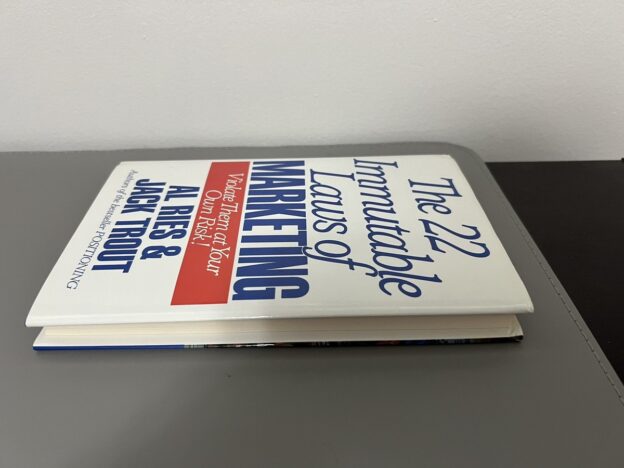In this punchy rulebook, Ries and Trout lay out 22 fundamental marketing principles, from the power of being first, to the dangers of brand extension. This article reviews each law’s strategic relevance, critiques the rigid tone of the book, and shows how to apply its timeless (if sometimes controversial) advice in a modern context.
Few marketing books have made a bolder promise than The 22 Immutable Laws of Marketing. Written by Al Ries and Jack Trout in 1993, this short, punchy classic lays out a rulebook that, according to the authors, you violate at your peril.
Each “law” is expressed as a principle of marketing strategy, some obvious, others provocative, all aimed at helping brands cut through the noise and dominate their category. While some readers find the tone overly rigid, the book’s real value lies in its clarity and contrarian wisdom.
Whether you’re launching a product, leading a brand, or planning your next move in a crowded market, this book serves as a powerful checklist and a series of warnings.
Contents
Summary: What Are the 22 Laws?
The laws cover a wide spectrum, from positioning and perception to timing, leadership, and focus. Notable examples include:
- Law of Leadership: It’s better to be first than it is to be better.
- Law of the Category: If you can’t be first in a category, create a new one.
- Law of the Mind: It’s better to be first in the mind than first in the marketplace.
- Law of Perception: Marketing is not a battle of products; it’s a battle of perceptions.
- Law of Focus: The most powerful concept in marketing is owning a word in the mind.
- Law of Line Extension: Stretching your brand across too many products leads to dilution.
These ideas underpin much of modern positioning theory, and they’re easy to absorb but harder to apply consistently.
Key Recommendations & Takeaways
1. Own a Word
“The most powerful concept in marketing is owning a word in the prospect’s mind.”
- Takeaway: Great brands are synonymous with one thing. Think Volvo = safety, FedEx = overnight, Google = search.
- Application: What single word or idea do you want your audience to associate with your business? Define it. Use it. Defend it.
2. Be First… or Reframe the Category
“If you can’t be first in a category, set up a new category you can be first in.”
- Takeaway: Leaders stick in the mind; followers don’t. But you can still win by redefining the game.
- Application: Don’t compete head-on. Create a niche, a sub-niche, or a unique point of entry.
3. Perception Beats Product
“Marketing is not a battle of products. It’s a battle of perceptions.”
- Takeaway: Quality is subjective. What matters is what people believe about you.
- Application: Craft a compelling narrative. Focus on perception-building through messaging, design, and consistency.
4. Avoid Line Extension Temptation
“When you try to be all things to all people, you wind up being nothing to nobody.”
- Takeaway: More isn’t better. It’s confusing. Don’t dilute your brand with unrelated products or vague positioning.
- Application: Keep your offerings tight. Launch sub-brands if needed, but protect the core identity at all costs.
5. Don’t Rely on Logic
“The mind doesn’t change easily. Once a perception is established, it’s hard to dislodge.”
- Takeaway: Facts rarely change minds. Stories and emotional anchors do.
- Application: Stop arguing with customers. Instead, reposition competitors and reinforce your distinctiveness.
Critical Analysis
Strengths
- Concise & Direct: Each law is clearly articulated and backed with real-world examples.
- Foundational Thinking: Many modern branding and positioning frameworks build on these core ideas.
- Iconoclastic: It challenges common marketing assumptions (e.g., that better products win).
Limitations
- Too Dogmatic?: Branding and markets evolve, and some “laws” may be more flexible than Ries and Trout admit.
- Few Digital Examples: The book predates the internet boom and doesn’t account for digital disruption or platform dynamics.
- Context-Blind: Some laws conflict depending on industry maturity, budget, or business model (e.g., bundling in SaaS).
Balanced View
These “laws” are best viewed as strategic tendencies, not absolutes. The real power of the book is not in obeying every rule, but in using the rules to force clarity. They’ll help you spot bad decisions before you make them, and sharpen your edge in brand strategy.
How to Apply the Laws in Daily Life
Choose a Word and Use It Everywhere
Decide what your product or personal brand means. Then, align your bio, tagline, email signature, and website around that concept.
Resist Feature Creep
Stick to your core offering. Keep your product roadmap focused. If a new idea doesn’t reinforce your position, it probably weakens it.
Test for Perception, Not Just Performance
Don’t just ask “How well does this product work?” Ask “How does this feel to the user?” or “What word comes to mind when they see it?”
When in Doubt, Simplify
Cut down your homepage, your pitch deck, your marketing copy. Every word you remove from your message makes what remains more powerful.
Final Thoughts
The 22 Immutable Laws of Marketing is a sharp, compact manifesto for anyone who wants to cut through the noise and build a durable brand. Its message is simple but radical: the market doesn’t reward complexity, it rewards clarity.
While the book’s tone can feel rigid, the principles are anything but outdated. In today’s fragmented attention economy, owning a word, framing the narrative, and staying focused have never been more essential.
Break the laws if you must, but only if you understand them first.
